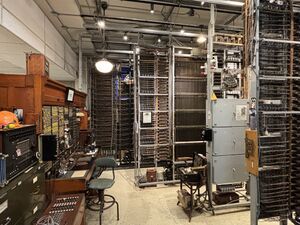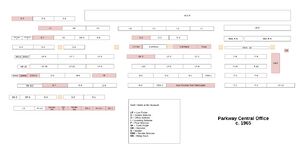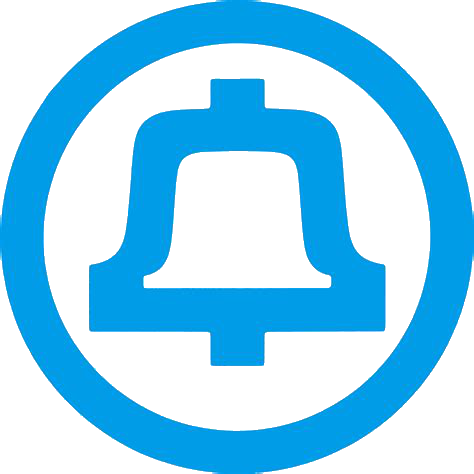CMS:Panel Switch

The Panel Switch was in service at the Rainier/Parkway exchange in Seattle from 1923-1974. The museum's Panel switch installation is an collection of a small fraction of components of the original switch, which was around eight times larger.
History
The Panel switch was installed in the Rainier/Parkway central office from 1921-1923 at the cost of approximately $294,000 (equivalent to $5,257,547 in 2023). Starting at 12 AM on March 3, 1923, it provided the first dial service to Seattle. On its opening day, it had approximately 4,000 lines connected and 36,199 originating calls were made from the switch.
In 1974 the Panel switch was decommissioned. Most of it was removed and scrapped, but the remaining frames were left in place because its wiring was mixed with other wiring that was still in use and the central office engineers were worried that severing the wires would cause a service outage.
In 1986 the remaining frames were transferred to the Connections Museum.

Configuration
Central Office
This configuration is as of 1965.
Number of Line Finder Frames: 12
- 6 old-style 300-point
- 6 new-style 400-point
Number of District Frames: 9
Number of Office Frames: 3 (post-1957)
Number of Senders: 72, in 8 frames (post-1956)
- 56 non-coin
- 16 coin
- 47, in 10 frames (pre-1956)
Number of Decoders: 3
- Each decoder operated in ⅓ second, thus one decoder could serve 12,000 originating calls per hour without a bottleneck, assuming call volume was steady.
- Altogether, 3 decoders could serve a theoretical max of 36,000 originating calls per hour.
- This number would have been much lower in the 1920s while the office was using translators instead of decoders.
Number of Incoming Frames: 10
- 60 selectors per frame. Total of 600 selectors.
- Theoretical max of 600 concurrent inbound calls, however it could not get this high in practice, due to the fact that incoming trunks were not evenly distributed, and the number of selectors on the final frame limited the number of calls that could be connected to a subscriber’s telephone.
Number of Final Frames: 11
- 480 available final selectors / 10,000 line capacity
Museum Configuration
Number of Line Finder Frames: maximum of 6 old-style 300-point
Number of District Frames: ?
Number of Office Frames: ?
Number of Senders: 6, in 2 frames
- non-coin/coin?
Number of Decoders: ?
Number of Incoming Frames: ?
Number of Final Frames: ?
Auxiliary Equipment
- OGT Desk*
- Tea Carts*
- #12 Local Test Desks*
- Chief Switchman’s Desk
- Automatic Routine Selector Test Frame*
- Decoder Test Frame*
- Decoder Trouble Indicator*
- Sender Test Frame*
- Stuck Sender/District Finder*
- Resistance lamp frame*
- District and Incoming coil racks
- A & B Operator Boards
- A & B Operator Test Boards
- Trunk Finder Frames*
- Interrupter Frames*
- Miscellaneous Relay Frames*
- Call Through Test Set*
- MDF & IDF*
- 800-Type Power Board*
- Gas-powered Generators
- Batteries
- Ringing Plant & Tone Supplies
- 2-Party District control frame*
- Message Register Cabinets*
- ~100 duplex motors running continuously*
- Floor Alarm Board 201♰
- District Coin Control frame♰
* indicates equipment that is on display at museum
♰ indicates equipment donated by Don Capehart in 2019
Statistics
Average normal daily load (1923): 13,000
